| Columns Retired Columns & Blogs |
Hopefully, there won't be any October surprises this year in 2020 :-) ........
Setup and use
Connecting, configuring, and using the 2108 was straightforward. As on the 2008, each of the three balanced-only inputs (Boulder supplies a set of RCA-to-XLR input cables) for both left and right channels features a "personality card" on a smoothly operating slide-out tray located below the input. A DIP switch on each sets MM or MC and either "low" or "high" (+10dB) gain. In MM mode, gain is either 40 or 50dB. In MC, it's either 60 or 70dB. The MC loading default is a sensible 100 ohms. The third input is intended for MM cartridge use. Its personality card has no load resistor, which produces from the circuit 47k ohms. When set to MC, the load is 1000 ohms.
You can obtain MM loads of 1000, 5000, 10,000, and 20,000 ohms by soldering in resistors, with values provided by Boulder in a chart that also offers MC resistor load options from 50 ohms to 1000 ohms in 25 ohm increments.
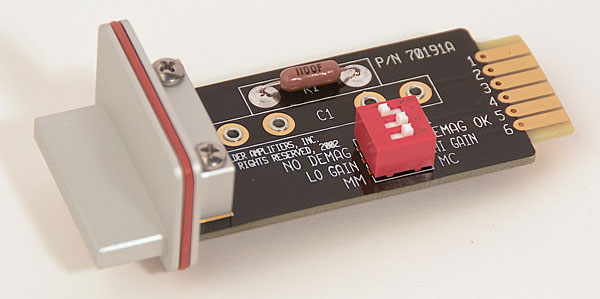
Boulder supplies an extra pair of "personality cards" with no resistors soldered in so you can add your own and then easily swap cards to hear the sonic differences. While that may sound a little DIY for a luxury product, soldering to the personality card is particularly easy and it allows you your choice of premium resistors, which you can be sure alters sonics.
The 2108 retains the 2008's convenient "demag" function that lets you plug your electronic MC cartridge demagnetizer into a pair of back-panel RCA jacks. At the push of a front-panel button, the 2108 routes the demagnetization signal to the cartridge. The "personality" card DIP switches let you select which inputs you want the demag signal routed to.
In terms of convenience of setup and use, as well as cosmetics, Boulder's 2108 is a luxurious product worthy of its steep price point.
Smoother sonic sailing?
Comparing the 2008's sonics with the 2108's without having both on hand is impossible. Anyway, my system has changed completely since 2002, as has cartridge technology. Today's best cartridges are neither analytical and astringent nor warm and bloomy. At one time, it seemed that at the top end of the market, those were your choices.
The Lyra Atlas Lambda playing back the "Bach Suites for Unaccompanied Cello" (Mercury/Analogue Productions SR3-9016), the production and mastering of which was supervised by Wilma Cozart Fine and Robert Fine's son Tom, created a believable, well-textured, 3D picture of a musician seated before me playing the instrument that no digits have ever produced in my listening experience: no unnaturally hard edges nor unnaturally soft and "romantic" ones. The picture of the cello was tightly focused, the surrounding space precisely delineated against a black background. When Starker tugs that bow across the strings, if it doesn't tug your midsection, what's the point? The 2108 produces both a sense of soaring exultation in the upper registers and gritty drama in the lowest one.
Playing the same Suite ("#2 In D Minor") through the Ypsilon VPS-100 produced a different picture: somewhat warmer, more diffuse, with more midband presence. The cello's image was less precise and more expansive, with less definition between the instrument and the space. However, the instrument's bass register produced a thrilling, majestic swell through the Ypsilon that the Boulder either suppressed or delivered with less added coloration, depending on your sonic perspective and tastes. Though clearly different, I found both appealing. The Ypsilon avoids bulbous bloom and the Boulder steers clear of sounding timbrally drab. Each one, though, veered in one direction or the other.
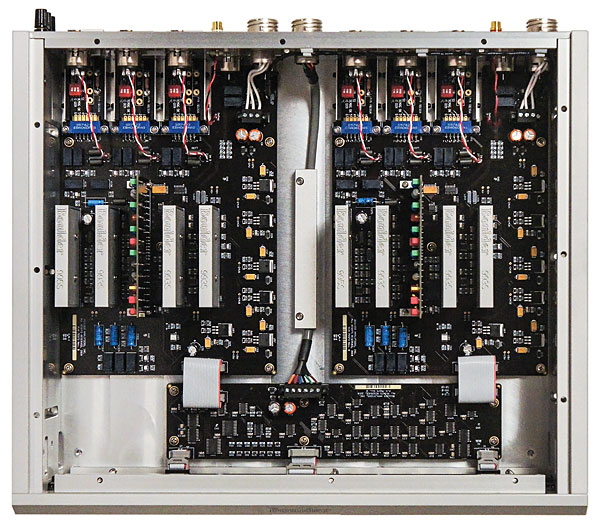
Afrobeat inventor and longtime Fela Kuti drummer Tony Allen passed away April 30 at 79 years old. In 2017, he co-composed and arranged all of the tracks on The Source (Blue Note France 5778336—also reissued by Blue Note America from the same pressing). This is a fascinating jazz–Afrobeat fusion album produced with no digital intervention. ("AAA Triple Analog" is on the front cover.) It's infused with brass and reeds and features Blur's Damon Albarn on piano.
It's a perfect test of the 2108's rendering of space, dynamics, timbre, transient precision—everything (but string tone. No strings attached.). This recording produced a warm sound through both the Ypsilon and the Boulder. You'd enjoy it both ways. There was more slam in the drums and a greater sense of stick-on-metal cymbals through the Boulder, plus more expansive front-to-back instrumental delineation, but I didn't favor one over the other.
I also checked out an original 1959 pressing of Barney Kessel Plays 'Some Like It Hot' (Contemporary S 7565) featuring Art Pepper, Shelly Manne, Jimmy Rowles, and other West Coast greats, engineered by Howard Holzer. This is a really warm outing in which the Boulder gets it all right on a huge, 3D stage. Kessel's hollow-bodied Guild is way out front and as rich, round, and juicy as you'd expect or want. Top to bottom, this Boulder produced the musical goods. If I told you the 2108 was a 508 on supersteroids, it would be paying it a high compliment. I am telling you that.
Still, the 2108 will not please bloom-fanciers. In navel terms, sonically, the Boulder is an innie, the Ypsilon more of an outie. The Audio Research Ref 3 I reviewed a few years ago was a way-outie. All are far out as far as I'm concerned. Boulder detractors who think their products are too analytical, sounding dry and bleached, ought to give the 2108 a listen, just as Lyra detractors ought to give the Atlas Lambda a listen before returning to their Koetsu silo. The 2108 is none of those things. It is very musical, plus, like the original 2008, it is granite-like in the best possible sense.
Consolidated Audio's "Monster Can"
A few months before last year's "Making Vinyl Berlin," I got an email from a fellow named Frank Wonneberg, whom I did not know. He'd heard from Bryan Ekus, one of the event's organizers, that I'd be coming to town, and he offered to pick me up at the airport very early in the morning.
He fetched me at the airport and took me on a tour of Berlin that, in addition to bucket-list stops like The Brandenburg Gate, included a few record-centric spots that few people know about, like a small, rundown car-repair joint that was where the Odeon and Parlophone labels were born in the early 20th century—as well as the first two-sided records. Mr. Wonneberg is a Frank Zappa discography expert and author of the giant coffee table book Grand Zappa, which is out of print.
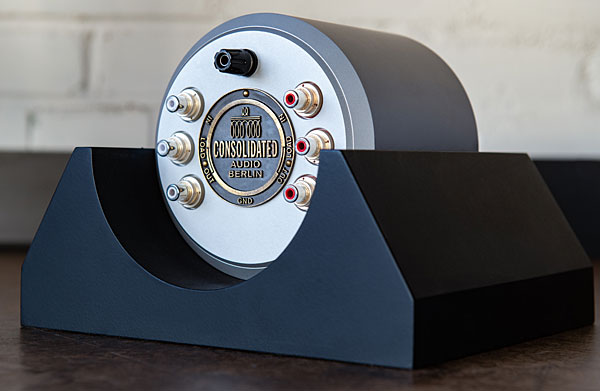
Later, we met for lunch with tonearm manufacturer and all-around vinyl genius Frank Schröder; after that, we did some record shopping at a huge outdoor fair. After visiting the apartment building where David Bowie lived (commemorated with a plaque that mistakenly claimed Bowie recorded "Heroes," "Low," and "The Lodger" in Berlin), we had dinner with a crew that included the two Franks and Consolidated Audio's Michael Ulbrich, an electrical engineer and transformer expert.
Despite an early-morning landing and a late-night finish, I didn't experience even a hint of jet-lag. In fact, it was difficult getting to sleep when that event-filled day drew near its end.
Consolidated (footnote 3) offers transformers using cores of either mu-metal—an 80% alloy of nickel balanced out with 12% to 15% iron and a variety of other elements (Consolidated calls it "Hi-Nickel")—or Nano Crystalline, which offers a number of technical advantages over normal ferrite cores and claims advantages over amorphous cores.
Either type of core can be wound with copper, 99.99% silver, or a mix of both. Consolidated offers SUTs with low (1:10/20dB), medium (1:15/23.5dB), or high (1:20/26dB) turns ratios, intended, respectively, for cartridges that output 0.5mV, 0.35mV, and 0.25mV. Used with a standard 47k ohm moving-magnet phono stage, the cartridge would "see" loads of 470, 209, and 118 ohms.
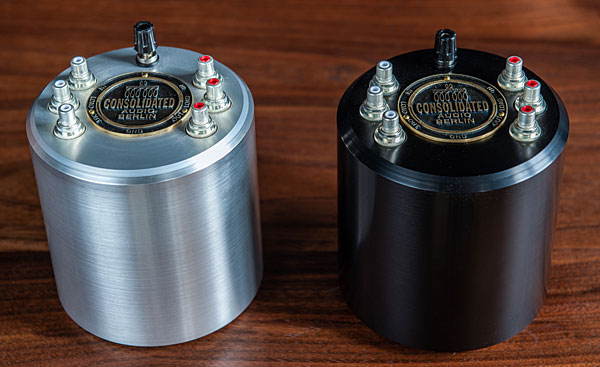
Oswalds Mill's Jonathan Weiss sent for review a transformer with a low-inductance Nano Crystalline core wound with silver wire in a 1:20 ratio, ideal for cartridges like the Ortofon Anna D and Lyra Atlas Lambda SL. (Lyra recommends a transformer-based load of between 1 and 10 ohms, though I'm not sure why that low.) The $5700 Consolidated transformer offers RCA loading jacks, but I chose to review it as is (a cartridge "sees" a 118 ohm load) and compare it to my Ypsilon MC-16L, which has a turns ratio of 16 and so has less gain and presents the cartridge with a higher load impedance (184 ohms with a standard 47k ohm MM load). The Ypsilon SUT features a proprietary amorphous core and is wound with copper wire. Here, I did load the secondary with 15K nude Vishay resistors to drop the impedance from 200 ohms to about 50. Ypsilon offers a silver-wire version that costs $18,600, for any turns ratio. I used my copper-wire version ($6600).
I compared the two transformers using the Atlas Lambda SL and the Ortofon Anna D, listening to the direct-to-disk Bruckner Symphony No.7 with Haitink conducting the Berlin Philharmonic I have mentioned in past columns. I also listened to the Electric Recording Company's Martzy Bach Unaccompanied Violin Sonatas Volume One (ERC001), the Decca Classical Stereo Sampler (DECCA SXL 6177), and the ORG edition of Rickie Lee Jones's Pop Pop (ORG 007). It was necessary to adjust levels, because the 20-turn Consolidated SUT produced a few decibels more gain than the 16-turn Ypsilon.
I was not kidding last month when I wrote that the CAD Ground Control system transformed the sound of my system. Still, I was taken aback when I played, for the first time since I installed the CAD system, the Bruckner LP that I'd repeatedly played to write my notes for the box. I knew what to expect, but what I got with either transformer was far more liquid, 3D, transparent, and timbrally spot-on, though it was originally quite good. Now the massed strings didn't exhibit even a hint of edge or brightness, and the see-into-the-picture sensation was greatly intensified.
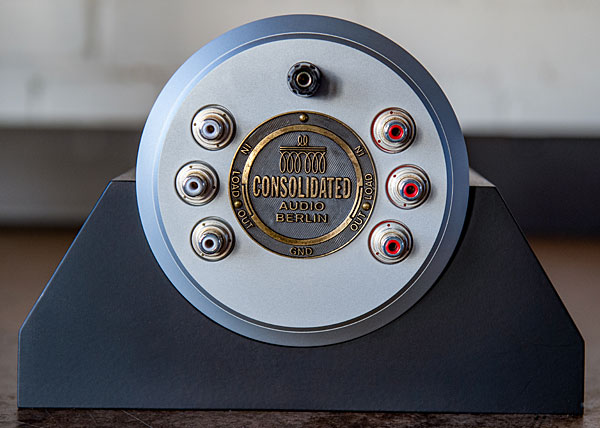
These are both outstanding, high-performance transformers. Both produced open, transparent, supple, rich sound. I also compared the Bob's Devices Sky 20, which, while easily the best value of the three, at $1375, couldn't compete in terms of bass control, transparency, high-frequency extension, or dynamics. I doubt the Bob's Devices SUT will be paired very often with a $52,000 phono preamp.
Even after level-matching, the Consolidated SUT delivered somewhat better bass microdynamics on "Up from the Skies" from Pop Pop, though the Ypsilon had better bass control. The nylon-string guitar was slightly more transparently real through the Consolidated. Rickie Lee Jones's voice was convincing through both.
On the Martzy solo violin, the Consolidated had more sheen on top while the Ypsilon was more burnished, with more body. On the Bruckner, the Ypsilon let me see further into the soundstage, and the strings were sweeter (even though the load was 470 ohms vs 120 on the Consolidated; a larger loading resistance should, if anything, mean more high frequencies). The Consolidated had the edge (no pun intended) on "The Toreador Song" from Carmen on the Decca compilation: There was more sheen on Nicolai Ghiaurov's vocal.
Which of these two transformers you prefer is a matter of system matching and sonic preference. While hardly inexpensive, the $5700 Consolidated SUT strikes me as a good deal, especially if you want silver wire

Hopefully, there won't be any October surprises this year in 2020 :-) ........

... will prove to be much more precise and measure (with an inverse network or pre-equalized test signal) much flatter than what Hi-Fi News found for the $5K "economy model" Boulder 508.
https://www.hifinews.com/content/boulder-508-phono-stage-lab-report
In that regard you'd be far better off with the $1,500 Parasound Halo JC3-Jr.
https://www.parasound.com/reviews/hi-fi-news-2018-2.pdf

...... an inverse network or pre-equalized test signal" quoted Ortofan.
So what even if the RIAA measured zero error. You think your ears can detect better sound ?????
Good sound or not is not based on the absolute RIAA accuracy !!!!
Better sound is based on the design of the RIAA gain stages involved.
IMO, the best phonostage design is built of PASSIVE RIAA equalization, not conventional 'active' RIAA EQ using loop feedback. It is the active loop feedback screws up the music signals. I know because I design/built my phonostages with PASSIVE RIAA EQ which blows away conventional RIAA feedback loop design sonically.
For phonostages, LESS active stages BETTER will be the sound. Don't believe the very wrong concept of more stages will better sound. It is the contrary technically & sonically.
My signature logo here shows the very very compact phonostage I design/built many years back: SINGLE one gain stage with PASSIVE RIAA EQ
followed by a single-gain-stage linestage. More than enough voltage gain to drive any power amps.
Simplicity delivers better sound.
Listening is believing
Jack L

I would normally roll my eyes at a comment that mentions measurements without any associated listening. But as an owner of the Boulder 508, I can say the measured upper midrange push is clearly audible when listening through the 508. On a front end that already leans in the direction of lean/analytical (AMG Giro, AMG Teatro) the Boulder is enough to push things over the edge on a good portion of my vinyl collection. On some records the presence boost (as I'll refer to it from now on, as its almost an identical effect to turning a tone/presence control up) is actually an improvement, particularly with simple and sparse arrangements. But on other records it is enough to make listening less than pleasurable - the extra upper mid energy can actually obscure detail, making it harder to hear texture and reverb tails. It can also push the sound stage so forward that it begins to sound a bit 2D.
Considering how good the 508 is in almost every other aspect, its a love/hate relationship I have with it at the moment. I have listened to a PS Audio Stellar phono in the same system, which sounds far better balanced in terms of its RIAA EQ, but I prefer the boulders overall signature (or lack of signature). I by far prefer the highs on the boulder which sound substanially more artifact free. Not to mention the bass is tighter and more articulate on the 508. At least in my system.
I have recently performed a little experiment, by piping the 508 through a Lynx Hilo running FabFilter to compensate for the presence boost. The result was quite eye opening. If the RIAA was a bit flatter on the 508, it would be more than good enough to be an "end game" phonostage for me. As it is, I'd have a hard time letting it go due to the stuff it does well. I just wish it was possible to send the thing back to Boulder for them to mod a bit more accuracy into the EQ, but I guess you cant have it all on an 'economy' model.

... flat (+/- 0.1dB) frequency response from a $500 phono preamp, such as the Clearaudio Nano Phono, then there's no reason why Boulder can't deliver comparable performance at ten times the price.
https://clearaudio.de/_assets/_pdf/reviews/electronics/nanophono_hifinews.pdf
Have you actually asked Boulder if they could adjust the EQ to make it more accurate?

Are you of the school that regards simple loudness uniformity as the de facto only measurement? I know that in your case that's not true. So who cares if a thing isn't utterly flat?
Get this: We can't even arrive at a decision which kinda sorta maybe flattish response the speaker must make to pass muster. Nobody can say, in all the din about speakers, which loudness uniformity graph constitutes The Holy Accurate Speaker. And if we could we couldn't hear it.
But phono stages? Oh my goodness. Look, flat does not conflate with 'performance'.
We're funny sometimes.

Would have liked to have seen the comparo include the Yipslion MC SUT + Zesto Allasso SUT in the mix .. but thanks for the Cinemag input.

I've seen this many times previously.
An owner of ultra pricy xxxxx tries out some comparably modest gear change to discover his flabbergastingly expensive gear now suddenly performs much better.
I can't help wondering why the previously wonderful gear is so weak by comparison?
Why not get dam good advice from someone in the first place?
Or
Does the performance of ultra gear have a Half-life like the Synthetic Oil in our car?, like the suspension in our Koetsu that relaxes a bit too much after a few months of careful playing?
Perhaps,
The ultra gear wasn't the ultra a performer that we earlier and impulsively convinced ourselves of.
On the other physical hand, our ears & nervous system develop pronounced shifts in perception that lead us into changing our opinions about how things actually are.
I ask: are any of our Opinions useful, since they seem to change as our lives advance?
It somehow seems a bit unfair for outfits to present pricy improvements to folks who's hearing systems are probably 8 db. down in the lower octaves and another 8 db. down in the upper octaves. Perhaps a 16 band equalizer from the Pro-Audio folks should now be an Audiologist calibrated part of our Music Systems.
And:
When a curious bystander observes a prominent improvement we might question how good our gear was in the first place.
Tony in Venice

... design (for high-output cartridges) all settled about 45 years ago?
http://hifisonix.com/wordpress/wp-content/uploads/2019/06/Tomlinson-Holman-phono-pre-research.pdf
If you're using a low-output cartridge, try a Jensen MC-2RR for $600.
https://www.jensen-transformers.com/product/mc-2rr-h/
https://www.jensen-transformers.com/product/mc-2rr-l/

"Before you whine about the price, consider that $29,000—the 2008's price when it was introduced—is $41,330.08 in today's dollars. So, the 2108 is really only about $12,000 more expensive. Don't you feel better?". In short, no, I don't. Either you are looking down on poor sods like most of us who can only read about products like these, or calling Boulder greedy bastards ;-)

............Don't you feel better?". In short, no, I don't. " quoted nirodha.
Hi
Give me a break, for $52,000 to buy a preamp built with op-amp IC chips !!!!!!
As a veteran HOBBY audio amps designer/builder for decades, the LAST gain components I would use are op-amp chips, thanks for my huge love of music backed up by my electrical/electronic background.
Why? An op-amp chip is built with many bipolar junction devices (or transistors) with tons loop feedbacks. This makes the music signals (built of complex waveforms of high order harmonics) to go thru this op-amps NOT as smoothly as discrete devices, like discrete FET, transistors or triode tubes!!!
I only gain devices I did, do & will be using for building audio amps re only TRIODE tubes, period.
Why? Triode tubes are the only LINEAR gain devices which get entire sets of linear signal transfer curves. Bipolar junction devices & op-amp chips ALL get non-linear signal transfer curves with a kink or 'knee'on each & every one of them. So this will limit the signal swing to avoid going into distortion zones!!!!
Sonically, IMO, op-amps sound clinical, apparently due to their built-in non-linearity & multiple feedbacks. My critical ears can tell even I were blindfolded. Triodes, being their inherent linerity, sound so natural & musical.
Listening to linear devices is believing
Jack L

... the following articles?
http://nwavguy.blogspot.com/2011/08/op-amps-myths-facts.html
https://linearaudio.net/sites/linearaudio.net/files/LA%20Vol%202%20Yaniger%281%29.pdf

Hi
Bench measurements always use sinewaves as test signals instead of real music signals. So apple to orange comparison as an audio amp amplifies music signals, NOT not sinewave test signals.
So what if the data of an op-amp chip measured 'perfect', it does not tell us at all how these chips would handle realtime music signals.
As said above here, technically, an op-amp is built of many bipolar junction devices (or transistors, FET etc) with tons of loop feedback.
It is the too many gain stages & loop feedback that screw up the proper passage pf the complex music signals comprising high orders of harmonics. Critical ears, such as mine, can tell.
Less no. of gain stages with ideally ZERO loop feedbacks, provide fast passage of complex music signals with much less harmonic distortion, crosstalks & phase distortion as occured in an op-amp.
We must understand measurement todate bears very litte, if not zip, relevance to what our brain perceive the music.
Listening is believing
Jack L

... what sort of test signal might meet your criteria for a "real music signal".
A square wave contains "high orders of harmonics".
Is that sufficiently "complex" for you?
But, it's also just the sum of multiple sine waves of different amplitudes.
How fast does the "passage of complex music signals" need to be?
Does having "ZERO loop feedbacks" really result in "much less harmonic distortion"?
Can you name an amplifier with "ZERO loop feedbacks" that has "much less harmonic distortion" than an amplifier with "tons of loop feedback"?
Your stated preference for tube amps suggests an acquired taste for "second harmonic sauce".

I am sure it is wonderful sounding, but to need this to play a $20+ LP to gain enjoyment is, well I don't really know what to say. If your turntable is $20-$50K, is that enough of a front end to make this worth it?
I would think you would need the best turntable/cartridge combo to justify this purchase and the rest of your system must be top notch as well, but since the sound of all the A+ gear is not the same, what is the "right sound"?
I am glad I don't have to worry about this issue. I will never own a half-million dollar system. My 73 year old ears could not appreciate it.
I hope that those who can afford it will truly enjoy it. I feel confident they will. I am glad there are engineers who will push the envelope higher as the trickle down engineering may help many others.

I have four turntables, all magnificent sounding (the fourth one will be setup shortly). Since I work from home nowadays, like all of us, I was spinning a record and was thinking how similar all of them sound. One a simple LP12 with Ittok LVIII MK2 sounds great and is bested by another one which has a better tonearm by just a few degrees - nothing major. The same with the cartridges; one has a top of the line Audio Technica which is a nice cartridge but it isn't that much better than the Shure V15 MK V MR's I got in rotation, and that I have owned for the last 30 years. The other issue is that I was able to buy these tables in the last ten years, as I can now afford them. But I am almost 55 and is my hearing going to get better to warrant paying thousands more for a better preamp or power amp or phono preamp? Just for a few degrees of improvement? I thought about all this reading this review. I have no doubt it is phenomenal, but if I were to bring it into my apt and plug it in would it be revelatory to my 55 year old ears? I have yet to hear any uberly priced gear that made me want to go out and buy it because it massively improved the way I listen to my music. However, it is always possible. I guess I should audition it.

I don't want to sound overly critical because I am not. My dad who is still around sometimes throws me words of wisdom that make tremendous sense. He tells me just to keep one turntable and enjoy my music. But I like others on these pages, love the gear. I have nothing but respect for these people that create this equipment; that actually build them from scratch, out of passion and love for the music. I also get why the prices are high in this day and age. Do not want to knock Boulder or any company trying to enrich our musical appreciation, just that there have been few pieces of equipment that moved me and some of it wasn't all that expensive.

MF could review the $72k Soulution 755 phono pre-amp, and do a comparison test :-) .......

I deleted my comment - I had misread the article. My apologies for any confusion.

My only other comments is how I test my hearing in the most simple way. I use recorded vocals to determine the "clarity" issues for all of my pedestrian gear. I will admit that the best phono stage I have ever owned was the Monolithic Sound with the power supply. I have never owned a phono cartridge over $500, my best being a Shure Type 5 MR, long gone with the Dual CS 5000, and now use a Shure M97 and a Ortofon OM30. All of this part of the proletariat landscape of audio for sure, yet I know that many have worse.
When I stop being able to understand the words a singer is trying to pronounce I know it is probably me, but on many albums I have no issues so I know it is me probably most of the time, not all, and my record playback system some of the time and I don't think that a phono stage would fix this without upgrading everything I own and start over totally new.
One of my favorite albums is Mary Chapin Carpenter's scenes From The Movies, great music and great story telling. I have a hard time understanding her singing with all formats, but my HD Tracks 2496 download is a big improvement and my new, very affordable Project S2 DAC a big help using my old disc spinners for a transport. If I listen on my AKG K701 cans it is better still. I have this same issue with Norah Jones on some albums.
I would also bet that the "mastering" for all of these formats is totally different which is also a part of it. I also know that it is not the fault of my gear for my hearing loss. There are probably many audiophiles my age (73) with the same issue.
That is why I really appreciate Michael doing all of his cartridge and cable tests with sound samples as downloads so I can make a hearing determination which might work better for me. I do pretty well p;icking out what the better is by vote of many of you. There is probably no cartridge or headphone too bright for me.
I will probably make one more change of phono stage and cartridge before I kick, but I am not getting my hopes up that it will be life changing. I don't know if even a $5 grand upgrade would do that with the HF loss I have.

On the basis of this review I bought one of these and it arrived just a few days ago. Wow! Cartridge is a SoundSmith Experion and phono stage is a Conrad-Johnson TEA1, series 3. I can't believe the improvement in imaging, detail, bass control. No down side that I can hear, not edgy. BTW, I am 72 years old and can't hear like I could 20 years ago, but I can hear this not very subtle improvement. Thanks Mikey.
Regards,
Bill Stevenson
West Palm Beach, FL

What speakers are you using? ..... Just curious :-) .....
